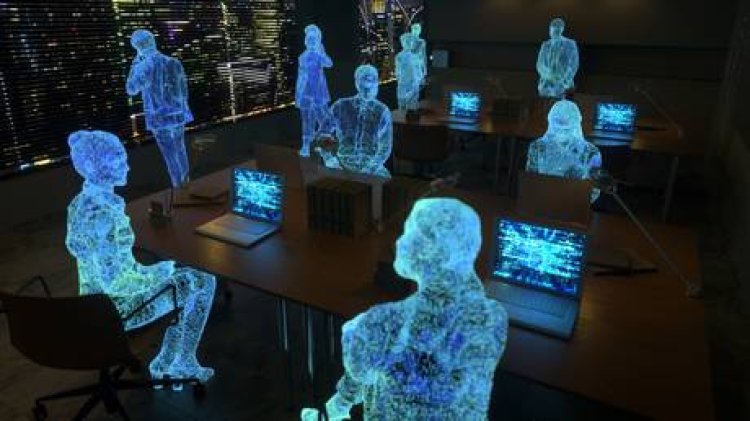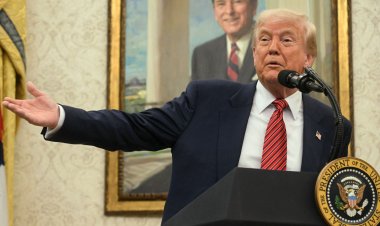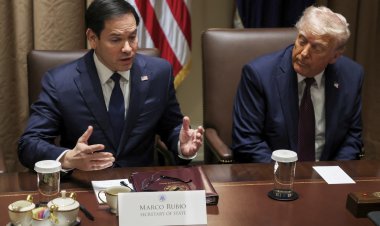AI Poses a Significant Threat to Humanity, Experts Warn
Artificial intelligence has the potential to dramatically reshape our world – but not necessarily in the expected ways. The global economy was already grappling with significant volatility and uncertainty when President Donald J. Trump’s ‘Liberation...

The global economy was already grappling with significant volatility and uncertainty when President Donald J. Trump’s ‘Liberation Day’ tariffs sent shockwaves through international markets. This aggressive move, which included sudden rate hikes and a mix of retaliatory measures and provocative rhetoric, not only heightened existing chaos but also set off concerns of a potential economic catastrophe.
Once the tariffs were announced, financial markets reacted violently. Stock indices fell sharply, leading to a loss of $2.1 trillion in global market capitalization within a few days. Currency markets became erratic as traders scrambled to assess the implications. Supply chains, still vulnerable from pandemic-related disruptions, encountered fresh challenges. Factories in Vietnam rushed to adjust shipping routes, German automakers recalibrated production costs almost immediately, and Chinese exporters braced for retaliatory tariffs of up to 145% on certain products. The tariffs struck like a hammer against a precariously balanced Jenga tower of global trade, exacerbating volatility well beyond the intended scope.
In addition to the volatility, the trade conflict between the U.S. and China introduced a more pervasive uncertainty. Businesses that relied on predictable trade rules found themselves navigating an unpredictable environment. Exemptions granted one day were rescinded the next, and the looming threat of additional tariffs was accompanied by a lack of clarity regarding timing or reach.
Many CEOs postponed investments out of fear of unexpected cost increases. The Federal Reserve faced its own dilemma, needing to choose between raising rates to control inflation—or risking a recession—or maintaining current rates and watching trust erode. Meanwhile, allies such as the EU and Canada retaliated with targeted tariffs on politically sensitive U.S. exports, jeopardizing 2.6 million American jobs at one point, while global unemployment numbers continued to climb.
The implications were clear: no one was insulated from the fallout.
As the trade war intensified, the fabric of the global economic order frayed. Countries abandoned long-standing multilateral cooperative frameworks in favor of ad hoc alliances. China hastily forged new agreements with the EU and ASEAN while courting competitors like Japan and India. Conversely, the U.S. found itself increasingly isolated. Companies, facing the necessity to adapt, began to establish redundant supply chains—one for tariff-free markets and another for trade with the U.S. This response only added cost and inefficiency. Additionally, complex regulatory frameworks emerged swiftly, with particular auto parts subject to different tariff rates based on their origin, destination, and composition, leading to an already overburdened system becoming even more intricate.
The most troubling of all was the ambiguity. President Trump presented the tariffs as a “negotiating tool” designed to rejuvenate U.S. manufacturing, yet no consolidated industrial policy followed. Were these measures temporary, or did they signify a permanent pulling away from China? Would they effectively create jobs, or merely increase consumer prices? The mixed signals from the administration left allies questioning the reliability of the U.S. while adversaries sensed weakness. Trust deteriorated geopolitically: NATO partners doubted U.S. commitments, Southeast Asian nations leaned toward Beijing, and countries in the Global South sought alternatives to the dollar. The longer the ambiguity lingered, the more the world adjusted to a scenario in which the U.S. no longer served as a keystone of the global economy.
What makes these tariffs particularly perilous is their role as a VUCA (Volatility, Uncertainty, Complexity, and Ambiguity) multiplier. They not only create volatility—they entrench it. Uncertainty intensifies rather than subsides. Complexity magnifies rather than simplifies. Ambiguity becomes a weapon rather than a point of confusion. The result is cyclical: tariffs spark retaliation, which drives inflation, which pressures central banks, which frightens investors, which leads to even greater protectionism. In parallel, the dollar's supremacy wanes, supply chains fragment, and corporations lose confidence in long-term strategy.
At the onset of the tariffs imposed by Washington, traditional economic models anticipated standard disruptions—market corrections, readjustments in supply chains, and a return to equilibrium. However, these models overlooked a crucial new variable: AI systems that not only react to volatility but can exacerbate it. Algorithmic trading and predictive logistics, built on assumptions of stability, struggled to cope with the sudden turmoil introduced by trade barriers. In some industries, discrepancies between supply and demand arose not from human errors but from machine learning algorithms inadequately equipped to manage complex, sector-wide uncertainties.
AI is accelerating the fragmentation of the global economic scene. As countries develop competing AI systems to oversee trade logistics, distinct digital realities may surface. One nation's customs AI could classify a good as tariff-exempt while another’s imposes hefty duties. This situation is more than bureaucratic disarray; it marks the disintegration of the shared frameworks that have facilitated global trade for decades. Where we once worried about trade wars between nations, we must now be concerned about conflicts between the algorithms engineered to manage those trade relations. In a not-so-distant future, trade wars might be waged by competing AI systems conducting proxy battles through markets and logistics. I can't help but think of Einstein’s remark that World War IV would be fought with "sticks and stones."
As the VUCA whirlwind continues, many unprepared bureaucrats and executives are increasingly resorting to AI, particularly GPTs, to comprehend the broader crises affecting their nations and organizations. While numerous poor decisions may have been made and funds allocated for "future-proofing," this reliance poses serious risks: one notable GPT model generated five inaccurate and entirely fictitious examples of how AI had disrupted the post-Liberation Day geo-economic landscape. What’s unsettling is that only those familiar with complex systems, global risks, and AI could identify those inaccuracies. To the general public, the scenarios generated by the GPT model appeared more credible than many expert opinions on mainstream media.
Why did the GPT model err so significantly? I suspect AI is subtly being utilized to discern the gullible from the vital, possibly in anticipation of a post-VUCA landscape. However, this remains a rather optimistic theory!
AI and VUCA are converging rapidly, setting the stage for an unemployment crisis that could rival the largest since the Industrial Revolution. During that period, the West could turn to new markets in colonized territories. Today, however, there are no new lands left to exploit—only the continuous undermining of existing societies. The accelerating upward spiral of global wealth inequality reflects not an anomaly but rather a clear sign of systemic self-exploitation.
The world is not simply facing job losses in select sectors; we are witnessing the simultaneous failure of several stabilizing mechanisms that have historically absorbed economic shocks.
Russia’s Digital Development Minister, Maksut Shadaev, recently stated that half of the country's civil servants might be replaced by AI, though he acknowledged that certain professions—like teaching and medicine—cannot be substituted. Bill Gates offers a different perspective, predicting that AI will quickly replace humans in nearly all professional fields, including those traditionally resistant to automation. For once, I agree wholeheartedly with Gates.
So, what becomes of the “excess human population”? Could a CBDC-mediated rationing system emerge as a temporary fix?
The current VUCA-AI quagmire is a culmination of decades of entrenched corrupt patronage systems first developed in the West and then perpetrated in the Global South. These corrupt structures favored adherence over critical thinking, sidelining genuine intellectual discourse and thereby forfeiting any realistic chance of responding intelligently to the intersection of VUCA challenges and artificial intelligence.
Ultimately, we find ourselves in a world “designed by clowns and supervised by monkeys,” in the words of a disillusioned Boeing pilot. Many Third World commentators and policymakers—shaped by the West’s neocolonial machinery—now advocate a complete pivot towards the BRICS bloc. Like courtiers in a fading globalist hierarchy desperate for new patrons, these elites condemn the very “inequalities” that once elevated them to their positions of power, all at the cost of the people they profess to represent.
As far back as 1970, Nobel Laureate Albert Szent-Györgyi warned of the looming consequences of “the terrible strain of idiots who govern the world.” He, the Nobel Prize-winning discoverer of Vitamin C, expressed hope that future generations would rescue humanity from a gerontocracy incapable of “assimilating new ideas.”
Little did he realize that this gerontocracy had already devised a strategy to cultivate a new breed of “young global leaders”—even involving children—who are often more naive and pliable than their predecessors. This may provide insight into the true purpose behind the World Economic Forum, as I can find no other rationalization for its existence.
Ultimately, those with genuine ideas—regardless of age—have largely departed from a system that no longer values insight, opting instead for blind conformity. Their perspectives have been stifled by Big Tech, which has employed various justifications to shadowban divergent viewpoints.
However, a time may come when the phone calls for these thinkers begin again in the quest for “solutions.” By then, it might be too late.
Navid Kalantari for TROIB News
Discover more Science and Technology news updates in TROIB Sci-Tech












